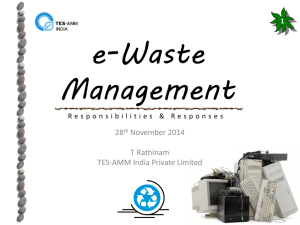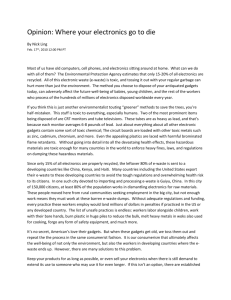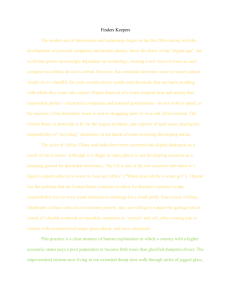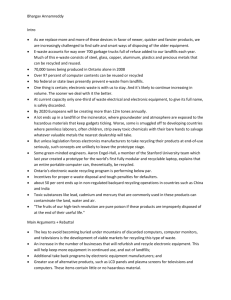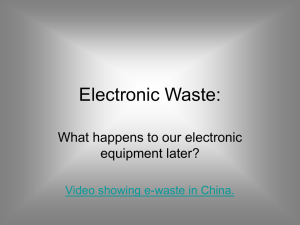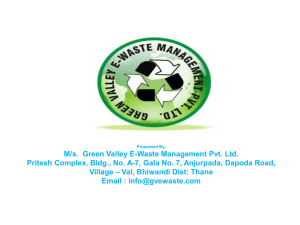EWW E-waste
advertisement
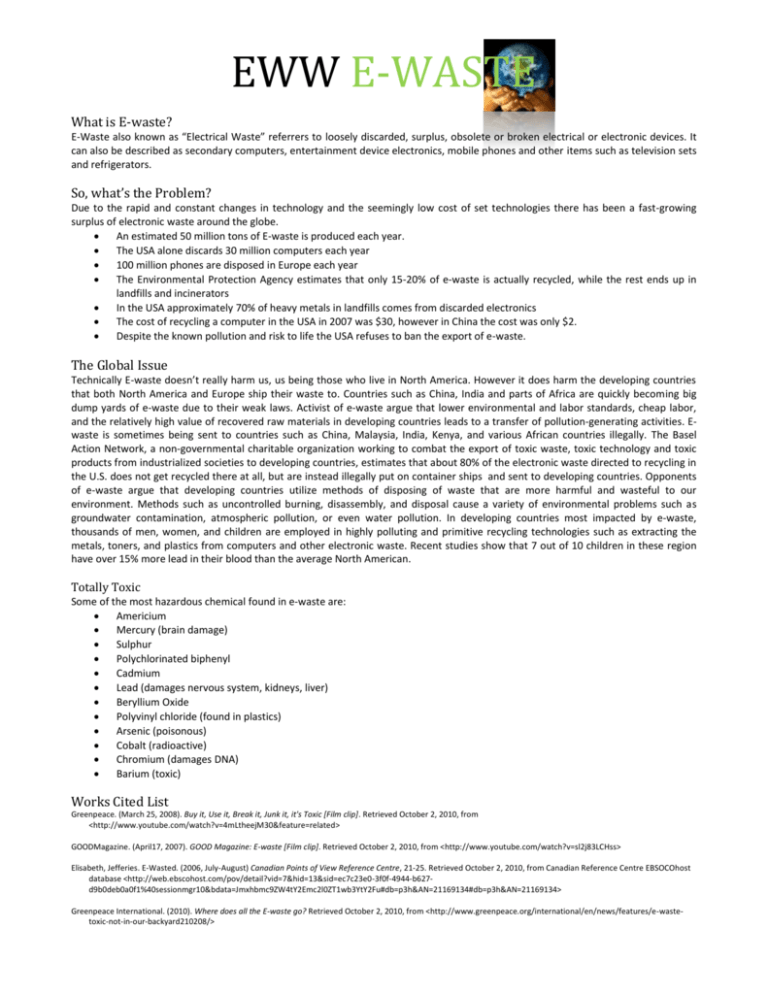
EWW E-WASTE What is E-waste? E-Waste also known as “Electrical Waste” referrers to loosely discarded, surplus, obsolete or broken electrical or electronic devices. It can also be described as secondary computers, entertainment device electronics, mobile phones and other items such as television sets and refrigerators. So, what’s the Problem? Due to the rapid and constant changes in technology and the seemingly low cost of set technologies there has been a fast-growing surplus of electronic waste around the globe. An estimated 50 million tons of E-waste is produced each year. The USA alone discards 30 million computers each year 100 million phones are disposed in Europe each year The Environmental Protection Agency estimates that only 15-20% of e-waste is actually recycled, while the rest ends up in landfills and incinerators In the USA approximately 70% of heavy metals in landfills comes from discarded electronics The cost of recycling a computer in the USA in 2007 was $30, however in China the cost was only $2. Despite the known pollution and risk to life the USA refuses to ban the export of e-waste. The Global Issue Technically E-waste doesn’t really harm us, us being those who live in North America. However it does harm the developing countries that both North America and Europe ship their waste to. Countries such as China, India and parts of Africa are quickly becoming big dump yards of e-waste due to their weak laws. Activist of e-waste argue that lower environmental and labor standards, cheap labor, and the relatively high value of recovered raw materials in developing countries leads to a transfer of pollution-generating activities. Ewaste is sometimes being sent to countries such as China, Malaysia, India, Kenya, and various African countries illegally. The Basel Action Network, a non-governmental charitable organization working to combat the export of toxic waste, toxic technology and toxic products from industrialized societies to developing countries, estimates that about 80% of the electronic waste directed to recycling in the U.S. does not get recycled there at all, but are instead illegally put on container ships and sent to developing countries. Opponents of e-waste argue that developing countries utilize methods of disposing of waste that are more harmful and wasteful to our environment. Methods such as uncontrolled burning, disassembly, and disposal cause a variety of environmental problems such as groundwater contamination, atmospheric pollution, or even water pollution. In developing countries most impacted by e-waste, thousands of men, women, and children are employed in highly polluting and primitive recycling technologies such as extracting the metals, toners, and plastics from computers and other electronic waste. Recent studies show that 7 out of 10 children in these region have over 15% more lead in their blood than the average North American. Totally Toxic Some of the most hazardous chemical found in e-waste are: Americium Mercury (brain damage) Sulphur Polychlorinated biphenyl Cadmium Lead (damages nervous system, kidneys, liver) Beryllium Oxide Polyvinyl chloride (found in plastics) Arsenic (poisonous) Cobalt (radioactive) Chromium (damages DNA) Barium (toxic) Works Cited List Greenpeace. (March 25, 2008). Buy it, Use it, Break it, Junk it, it's Toxic [Film clip]. Retrieved October 2, 2010, from <http://www.youtube.com/watch?v=4mLtheejM30&feature=related> GOODMagazine. (April17, 2007). GOOD Magazine: E-waste [Film clip]. Retrieved October 2, 2010, from <http://www.youtube.com/watch?v=sl2j83LCHss> Elisabeth, Jefferies. E-Wasted. (2006, July-August) Canadian Points of View Reference Centre, 21-25. Retrieved October 2, 2010, from Canadian Reference Centre EBSOCOhost database <http://web.ebscohost.com/pov/detail?vid=7&hid=13&sid=ec7c23e0-3f0f-4944-b627d9b0deb0a0f1%40sessionmgr10&bdata=Jmxhbmc9ZW4tY2Emc2l0ZT1wb3YtY2Fu#db=p3h&AN=21169134#db=p3h&AN=21169134> Greenpeace International. (2010). Where does all the E-waste go? Retrieved October 2, 2010, from <http://www.greenpeace.org/international/en/news/features/e-wastetoxic-not-in-our-backyard210208/>



